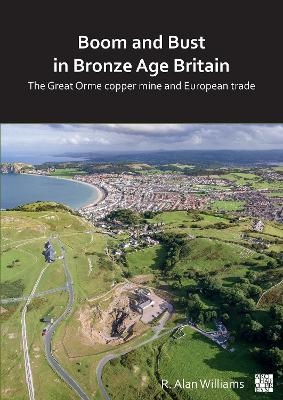
Boom and Bust in Bronze Age Britain: The Great Orme Copper Mine and European Trade
Archaeopress Archaeology (Verlag)
978-1-80327-378-5 (ISBN)
The Great Orme copper mine on the coast of north Wales is one of the largest surviving Bronze Age mines in Europe. But where did all the copper go? Until now this remained something of a mystery. It was claimed in the 1990s that the mine only produced a low impurity type of copper that was uncommon in the British Bronze Age. These claims had marginalised the mine as an unimportant copper source, whose extensive workings were explained away as being merely the result of small-scale workings over nearly a thousand years. However, the results of this new interdisciplinary research, which combines archaeological and geological knowledge with the latest scientific analytical methods, radically changes that picture. This new evidence reveals a copper mine of European importance, which dominated Britain’s copper supply for two centuries (c. 1600-1400 BC), with some metal reaching mainland Europe stretching from Brittany to the Baltic. This zenith period of large-scale production is thought to have required a full-time mining community, possibly supported or controlled by the agriculturally richer area of north-east Wales with its strategic links into wider communication networks. Overall, the new evidence suggests that Britain was far more integrated into European trade/exchange networks than was previously suspected.
Dr R. Alan Williams completed his PhD on the Great Orme Bronze Age copper mine in 2018 in the Department of Archaeology, Classics and Egyptology at the University of Liverpool, where he is an Honorary Research Fellow. He originally graduated with a BSc (Hons) in Mining Geology from the Royal School of Mines, Imperial College London, and after initially working in metal mining and exploration he had a long research career with the international glass company Pilkington (now NSG). He was head of the Raw Materials and Glass Compositions Department at the company’s international research centre and was responsible for sourcing glass-making raw materials in over 20 countries. Since taking early retirement in 2012 he has been applying his expertise in geochemistry, ore geology, mineralogy and pyrotechnology to important archaeological challenges in the field of prehistoric metal mining and smelting. He has written several papers and three books on historic and prehistoric metal mining areas in Britain and Ireland. He also has a long-standing interest in Bronze Age tin since working at Wheal Jane tin mine in Cornwall as a student geologist nearly 50 years ago. He jointly initiated the Leverhulme-funded Bronze Age tin project to determine whether the exceptionally rich tin deposits of Cornwall and Devon powered the major technological and cultural transition from copper to full tin-bronze across Europe and beyond. He is currently a Post-Doctoral Research Associate in the Department of Archaeology at Durham University. He was awarded the Ben Cullen Prize in 2020 by the Antiquity Trust and was elected as a Fellow of the Society of Antiquaries in 2022.
Summary ;
About the Author ;
Acknowledgements ;
Chapter 1: Introduction ;
Chapter 2: The Bronze Age research context ;
Chapter 3: Bronze Age mining and smelting ;
Chapter 4: Great Orme mine site and Pentrwyn smelting site ;
Chapter 5: Review of metal characterisation and provenance techniques ;
Chapter 6: Methodology, materials and analytical methods ;
Chapter 7: Results: Defining the Great Orme mine-based metal group ;
Chapter 8: Results: Great Orme ore mineralogy and Pentrwyn slag studies ;
Chapter 9: Discussion and interpretation ;
Chapter 10: Conclusions and future work ;
Bibliography ;
Appendix I: Compilation of published chemical analyses of ores from the British and Irish Bronze Age copper mines ;
Appendix II: Compilation of Cornish copper ore analyses ;
Appendix III: Histograms and correlation coefficients on the chemical analyses of Great Orme copper ores ;
Appendix IV: Chemical analyses of Group I palstaves (extracted from OXSAM database) ;
Appendix V: Compilation of published lead isotope analyses from the British and Irish Bronze Age copper mines not included in Table 7.11 ;
Index
| Erscheinungsdatum | 06.02.2023 |
|---|---|
| Zusatzinfo | 218 figures, 36 tables (colour throughout) |
| Verlagsort | Oxford |
| Sprache | englisch |
| Maße | 205 x 290 mm |
| Gewicht | 1297 g |
| Themenwelt | Geisteswissenschaften ► Archäologie |
| Geschichte ► Allgemeine Geschichte ► Vor- und Frühgeschichte | |
| ISBN-10 | 1-80327-378-X / 180327378X |
| ISBN-13 | 978-1-80327-378-5 / 9781803273785 |
| Zustand | Neuware |
| Haben Sie eine Frage zum Produkt? |
aus dem Bereich


